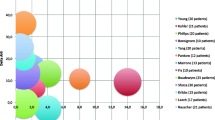Abstract
Purpose
The capacity for performing sleep study is limited. We made a simulation to study whether a diagnosis of obstructive sleep apnoea syndrome (OSAS) and prescription of nasal continuous positive airway pressure (CPAP) therapy would be possible and cost-effective without performing a sleep study.
Methods and objectives
One hundred ninety-seven consecutive patients referred to a pulmonary clinic due to suspected OSAS were included. Professional drivers, patients with neurological diseases, heart failure or aged <25 years were excluded. Two experts evaluated patient records retrospectively in a stepwise manner. In step 1, they were blinded to the sleep study results, and in step 2, the results were available.
Results
Mean age was 51.5 ± 10.8 years, BMI 31.9 ± 7.2 kg/m2, apnoea–hypopnoea index 19.8 ± 20.7/h and Epworth Sleepiness Scale 8.3 ± 4.7. Without sleep study results, the experts would initiate CPAP in 52.5% of patients (step 1), equalling to 74.7% of those whom they would suggest it after reviewing the sleep studies (step 2). In step 2, they suggested CPAP for 70.3% of all patients, while the clinicians responsible for the treatment for 66%. Net savings equal to the costs of CPAP device with interface for 50–100% of patients in need of this therapy depending on whether calculations are based on the costs of cardiorespiratory polygraphy or polysomnography.
Conclusions
Nasal CPAP therapy would be possible to initiate without a sleep study for the majority of patients with suspected OSAS resulting in significant cost reduction.

Similar content being viewed by others
References
Marin JM, Carrizo SJ, Vicente E, Agusti AG (2005) Long-term cardiovascular outcomes in men with obstructive sleep apnoea–hypopnoea with or without treatment with continuous positive airway pressure: an observational study. Lancet 365(9464):1046–1053
Young T, Finn L, Peppard PE, Szklo-Coxe M, Austin D, Nieto FJ, Stubbs R, Hla KM (2008) Sleep disordered breathing and mortality: eighteen-year follow-up of the Wisconsin sleep cohort. Sleep 31:1071–1078
Young T, Evans L, Finn L, Palta M (1997) Estimation of the clinically diagnosed proportion of sleep apnea syndrome in middle-aged men and women. Sleep 20:705–706
American Academy of Sleep Medicine Task Force (1999) Sleep-related breathing disorders in adults: recommendations for syndrome definition and measurement techniques in clinical research. The Report of an American Academy of Sleep Medicine Task Force. Sleep 22:667–689
Flemons WW, Douglas NJ, Kuna ST, Rodenstein DO, Wheatley J (2004) Access to diagnosis and treatment of patients with suspected sleep apnea. Am J Respir Crit Care Med 169:668–672
Kushida CA, Littner MR, Morgenthaler T, Alessi CA, Bailey D, Coleman J Jr, Friedman L, Hirshkowitz M, Kapen S, Kramer M, Lee-Chiong T, Loube DL, Owens J, Pancer JP, Wise M (2005) Practice parameters for the indications for polysomnography and related procedures: an update for 2005. Sleep 28:499–521
Kingshott RN, Vennelle M, Hoy CJ, Engleman HE, Deary IJ, Douglas NJ (2000) Predictors of improvements in daytime function outcomes with CPAP therapy. Am J Respir Crit Care Med 161:866–871
Loube DI, Gay PC, Strohl KP, Pack AI, White DP, Collop NA (1999) Indications for positive airway pressure treatment of adult obstructive sleep apnea patients. A consensus statement. Chest 115:863–866
McArdle N, Devereux G, Heidernejad H, Engleman HM, Mackay TW, Douglas NJ (1999) Long-term use of CPAP therapy for sleep apnea/hypopnea syndrome. Am J Respir Crit Care Med 159:1108–1114
Skomro RP, Kryger MH (1999) Clinical presentations of obstructive sleep apnea syndrome. Prog Cardiovasc Dis 41:331–340
Rowley JA, Aboussouan LS, Badr MS (2000) The use of clinical prediction formulas in the evaluation of obstructive sleep apnea. Sleep 23:929–938
Johns MW (1991) A new method for measuring daytime sleepiness: the Epworth Sleepiness Scale. Sleep 14:540–545
Goldberg DP, Gater R, Sartorius N, Ustun TB, Piccinelli M, Gureje O, Rutter C (1997) The validity of two versions of the GHQ in the WHO study of mental illness in general health care. Psychol Med 27:191–197
Grant JM (1991) The fetal heart rate trace is normal, isn’t it? Observer agreement of categorical assessments. Lancet 337:215–218
Flemons WW, Whitelaw WA, Brant R, Remmers JE (1994) Likelihood ratios for a sleep apnea clinical prediction rule. Am J Respir Crit Care Med 150(5 Pt 1):1279–1285
Kapsimalis F, Kryger MH (2002) Gender and obstructive sleep apnea syndrome, part 1: clinical features. Sleep 25:412–419
Svensson M, Franklin KA, Theorell-Haglöv J, Lindberg E (2008) Daytime sleepiness relates to snoring independent of the apnea–hypopnea index in women from the general population. Chest 134:919–924
Kushida CA, Littner MR, Hirshkowitz M, Morgenthaler TI, Alessi CA, Bailey D, Boehlecke B, Brown TM, Coleman J Jr, Friedman L, Kapen S, Kapur VK, Kramer M, Lee-Chiong T, Owens J, Pancer JP, Swick TJ, Wise MS, American Academy of Sleep Medicine (2006) Practice parameters for the use of continuous and bilevel positive airway pressure devices to treat adult patients with sleep-related breathing disorders. Sleep 29:375–380
Lloberes P, Ballester E, Montserrat JM, Botifoll E, Ramirez A, Reolid A, Gistau C, Rodriguez-Roisin R (1996) Comparison of manual and automatic CPAP titration in patients with sleep apnea/hypopnea syndrome. Am J Respir Crit Care Med 154:1755–1758
Desai H, Patel A, Patel P, Grant BJ, Mador MJ (2009) Accuracy of autotitrating CPAP to estimate the residual apnea–hypopnea index in patients with obstructive sleep apnea on treatment with autotitrating CPAP. Sleep Breath 13:383–390
Senn O, Brack T, Russi EW, Bloch KE (2006) A continuous positive airway pressure trial as a novel approach to the diagnosis of the obstructive sleep apnea syndrome. Chest 129:67–75
Acknowledgements
Sirkka Hakko, practical nurse; Satu Hemling, RN; Sari Melkko-Partanen, RN and Maija Nevä, practical nurse, are acknowledged for gathering and blinding of the data. Hans Helenius, MSc, is acknowledged for statistical advice.
Conflict of interest
The authors declare that they have no conflict of interest.
Author information
Authors and Affiliations
Corresponding author
Rights and permissions
About this article
Cite this article
Anttalainen, U., Liippo, K. & Saaresranta, T. Diagnosis and initiation of nasal continuous positive airway pressure therapy for OSAS without a preceding sleep study?. Sleep Breath 15, 791–797 (2011). https://doi.org/10.1007/s11325-010-0440-6
Received:
Revised:
Accepted:
Published:
Issue Date:
DOI: https://doi.org/10.1007/s11325-010-0440-6




